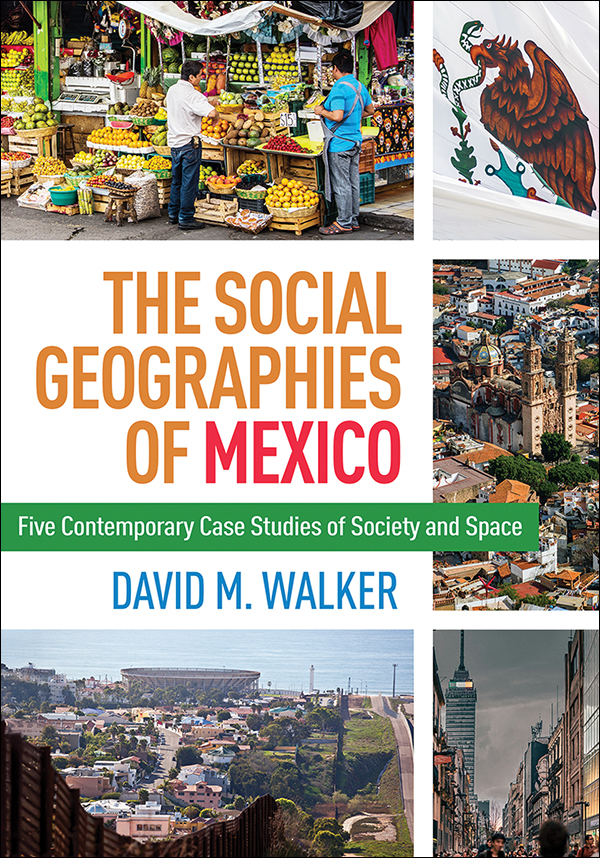The Social Geographies of Mexico
Five Contemporary Case Studies of Society and Space
David M. Walker
- Chapter Outline
- Why Study Mexico?
- Social Relations, Society, and Space: What Is Social Geography?
- Indigenous Mexico
- Indigenous Civilizations
- Indigenous Technology
- Mestizaje
- Indigenous Identity and Mestizaje
- 20th- and 21st-Century Mexico
- La Dictádura Perfecta
- Shifts from PRI Economics to Neoliberalism
- Zapatismo
- Multicultural Mexico?
- Methods and Book Online
- Chapter 2: Shrines of the Times: The Social Geographies of Contested Space in Tepito and the Historic Center of Mexico City
- Chapter 3: Identity and Place: The Social Geographies in the Costa Chica of Guerrero and Oaxaca
- Chapter 4: The Social Geographies of Tijuana: Urbanization at the U.S.–Mexico Border
- Chapter 5: In the Dumps: The Social Geographies of Trash
- Chapter 6: Zoque Indigenous-Produced Space: Social Geographies of Los Chimalapas
- Who Is This Book For?
- How to Use this Book
- Suggested Readings
2. Shrines of the Times: The Social Geographies of Contested Space in Tepito and the Historic Center of Mexico City
- Chapter Outline
- A Brief History of Mexico City
- What Is La Santa Muerte?
- Santa Muerte Worshippers in the Tepito Neighborhood
- Rapid Urbanization and Economic Shifts from ISI to Neoliberalism
- The Implosion of ISI
- Vignette: Migration, Emigration, and Neoliberalism
- The Production of the Informal Economy
- Coping with Neoliberalism
- Saving the Historic Center? But from Whom and for Whom? El Programa de Rescate del Centro Histórico
- The Appropriation or Rebranding of Tepito
- The Appropriation of Urban Space through Street Vending, Worship, and Food: Día de los Muertos in Tepito at Number 12 Alfarería Street
- Neoliberal Success?
- Conclusion
- Discussion Questions
- Suggested Readings
3. Identity and Place: The Social Geographies in the Costa Chica of Guerrero and Oaxaca
- Singing the National Anthem in Mexico City
- Where Is the Costa Chica Today?
- Regions in Oaxaca and Guerrero
- Africans in Mexico
- Vignette: Geography Matters: Human–Environment–Diasporic Interactions and Environmental Determinism
- Afromexicanos of La Costa Chica: A Legendary History
- Mestizaje–Raza Cosmica
- Identity and Regions
- Indigeneity and the Emergent Afromexicano Civil Society
- From Indigenous Autonomy to Black Recognition
- Fissures between Place and Identity
- Does Getting Counted Count? Economic and Social Development in the Costa Chica
- Discussion Questions
- Suggested Readings
4. The Social Geographies of Tijuana: Urbanization at the U.S.–Mexico Border
- Migration, Irregular Settlements and Neighborhood Formation
- Introduction
- Where Is Tijuana?
- Tijuana’s Topography and Its Impacts on the Environment
- A City Shaped from Both Sides
- Vice Tourism and Urban Expansion
- Social Geographies of Housing in Tijuana: Irregular Settlements
- PRONAF and Geographies of Uneven Urbanization
- Border City Morphology
- The Border Industrialization Program (BIP) and Urbanization
- A Cosmopolitan Mexican City: Demographics and Economic Diversification
- Tijuanenses Embody the Social Geographies of Music and Gastronomy
- Tijuana Music
- Tijuana Gastronomy
- The Mexican Dream in Tijuana?
- Discussion Questions
- Suggested Readings
5. In the Dumps: The Social Geographies of Trash
- Waiting on the Trash Man
- Chapter Outline
- Who Are the Pepenadores?
- Demographics and Garbage
- Conceptualizing the Value of Garbage
- A Day in the Life of Mexico City Garbage
- Vignette: The Temporal–Social Construction of Value
- Pepenador Efficiency, the Informal Economy, and the Social Structure of Urban Mexico
- Pepenadores, Caciques—Client Patron Relations, and the Social Structure of Urban Mexico
- The Neoliberalization of Garbage
- Environmental Activism and the Closing of Bordo-Poniente Landfill
- The Professionalization of Caciqusmo: la Confederación Nacional de Industriales de Metales y Recicladores (CONIMER)
- Alpuyeca Does Not Want Mexico City Trash
- Can La Pepena Be Included in Mexico City’s Waste Management Transformation?
- Discussion Questions
- Suggested Reading
6. Zoque Indigenous-Produced Space: Social Geographies of Los Chimalapas
- Introduction
- The Second Most Remote Region in All of Mexico
- Reverse Settler Colonialism
- State Government Structure, Customs and Traditions, and Communal Property Communities in Los Chimalapas
- Structures in Los Chimalapas
- Geography, Resources, and Politics in Los Chimalapas
- Confrontation and Cooptation in Los Chimalapas
- The Conflation of Nature and Society in Los Chimalapas
- Ethnospatial Politics
- Conclusion
- Discussion Questions
- Suggested Resource



